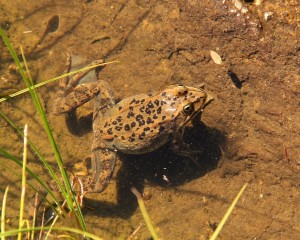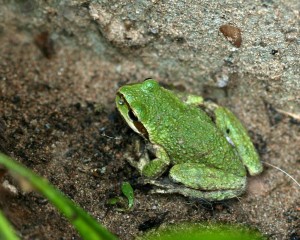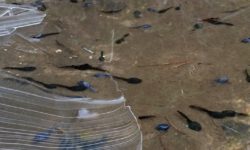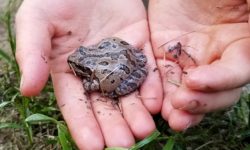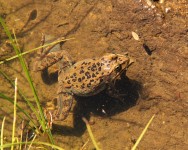In the spring, I’m always listening for the first robin to sing and the first frog to ribbit. But in the fall, I never know if an insect song or frog croak will be the last I hear until spring.
Just a few weeks ago a frog croaking caught my attention. Not only because it was October and I thought the frog should be settled in for winter (though it has been unseasonably warm) but because I heard it on a dry, ponderosa pine hillside. What was a frog doing up there away from water?
Shouldn’t frogs be down in the mud on the bottom of ponds with turtles for the winter? Apparently not.
Some frogs are considered terrestrial frogs, such as wood frogs, and hibernate on land. They aren’t good diggers so they seek out deep cracks and crevices to lodge themselves into for the winter. Or they dig as deep as they can into leaf litter.
Most terrestrial frogs freeze but they won’t die. A frog will stop breathing, the heart will stop beating and most of the frog will freeze solid but the frog won’t die. A high concentration of glucose in the blood keeps the frog’s vital organs from freezing so in the spring when the frog thaws out it resumes normal functions.
Not all frogs turn into frogsicles. Leopard frogs and bullfrogs typically hibernate underwater but not down in the mud with turtles because they would suffocate.
Even though frogs can breathe through their thin, moist skin they wouldn’t be able to obtain enough oxygen while being completely buried in the mud. So instead these aquatic frogs seek out oxygen-rich water and either rest on top of the mud or partially bury themselves. They even swim around occasionally but probably don’t find anything to eat.
Frogs typically eat insects and spiders which are in short supply in the winter. But in the summer, frogs are extremely beneficial for insect control. They can nab an insect and gobble it up in less than a second–all with their eyes shut.
Did you realize frogs swallow with their eyes? If you have ever watched a frog eat, they seem to blink as they eat. When blinking, the eyeballs push down on the top of the mouth which helps push food down the throat.
A frog’s sticky tongue helps it catch food to eat but one source of food they wear–their skin. Frogs shed their skin about once a week by pulling it over their head like a shirt. They usually eat the skin because it contains valuable nutrients.
At least we can be certain that frogs won’t be eating their skin while frozen solid in a deep crevice this winter. They will enjoy that “treat” when we begin hearing them next spring.

